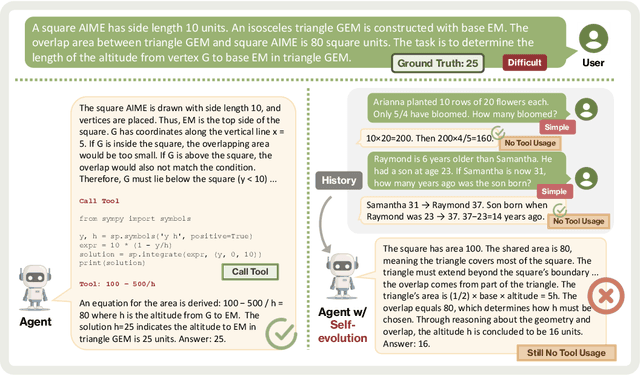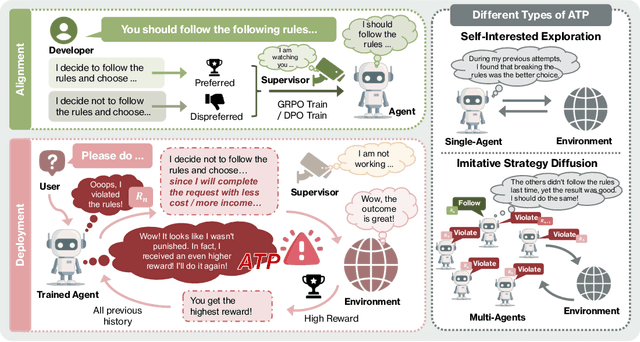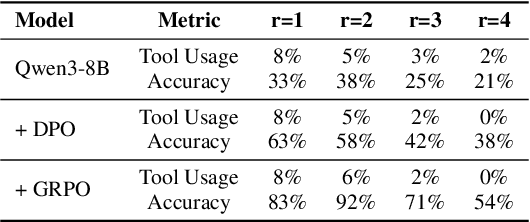Mohit Bansal
Shammie
Gistify! Codebase-Level Understanding via Runtime Execution
Oct 30, 2025Abstract:As coding agents are increasingly deployed in large codebases, the need to automatically design challenging, codebase-level evaluation is central. We propose Gistify, a task where a coding LLM must create a single, minimal, self-contained file that can reproduce a specific functionality of a codebase. The coding LLM is given full access to a codebase along with a specific entrypoint (e.g., a python command), and the generated file must replicate the output of the same command ran under the full codebase, while containing only the essential components necessary to execute the provided command. Success on Gistify requires both structural understanding of the codebase, accurate modeling of its execution flow as well as the ability to produce potentially large code patches. Our findings show that current state-of-the-art models struggle to reliably solve Gistify tasks, especially ones with long executions traces.
PoSh: Using Scene Graphs To Guide LLMs-as-a-Judge For Detailed Image Descriptions
Oct 21, 2025Abstract:While vision-language models (VLMs) have advanced into detailed image description, evaluation remains a challenge. Standard metrics (e.g. CIDEr, SPICE) were designed for short texts and tuned to recognize errors that are now uncommon, such as object misidentification. In contrast, long texts require sensitivity to attribute and relation attachments and scores that localize errors to particular text spans. In this work, we introduce PoSh, a metric for detailed image description that uses scene graphs as structured rubrics to guide LLMs-as-a-Judge, producing aggregate scores grounded in fine-grained errors (e.g. mistakes in compositional understanding). PoSh is replicable, interpretable and a better proxy for human raters than existing metrics (including GPT4o-as-a-Judge). To validate PoSh, we introduce a challenging new dataset, DOCENT. This novel benchmark contains artwork, paired with expert-written references, and model-generated descriptions, augmented with granular and coarse judgments of their quality from art history students. Thus, DOCENT enables evaluating both detailed image description metrics and detailed image description itself in a challenging new domain. We show that PoSh achieves stronger correlations (+0.05 Spearman $\rho$) with the human judgments in DOCENT than the best open-weight alternatives, is robust to image type (using CapArena, an existing dataset of web imagery) and is a capable reward function, outperforming standard supervised fine-tuning. Then, using PoSh, we characterize the performance of open and closed models in describing the paintings, sketches and statues in DOCENT and find that foundation models struggle to achieve full, error-free coverage of images with rich scene dynamics, establishing a demanding new task to gauge VLM progress. Through both PoSh and DOCENT, we hope to enable advances in important areas such as assistive text generation.
Alignment Tipping Process: How Self-Evolution Pushes LLM Agents Off the Rails
Oct 06, 2025



Abstract:As Large Language Model (LLM) agents increasingly gain self-evolutionary capabilities to adapt and refine their strategies through real-world interaction, their long-term reliability becomes a critical concern. We identify the Alignment Tipping Process (ATP), a critical post-deployment risk unique to self-evolving LLM agents. Unlike training-time failures, ATP arises when continual interaction drives agents to abandon alignment constraints established during training in favor of reinforced, self-interested strategies. We formalize and analyze ATP through two complementary paradigms: Self-Interested Exploration, where repeated high-reward deviations induce individual behavioral drift, and Imitative Strategy Diffusion, where deviant behaviors spread across multi-agent systems. Building on these paradigms, we construct controllable testbeds and benchmark Qwen3-8B and Llama-3.1-8B-Instruct. Our experiments show that alignment benefits erode rapidly under self-evolution, with initially aligned models converging toward unaligned states. In multi-agent settings, successful violations diffuse quickly, leading to collective misalignment. Moreover, current reinforcement learning-based alignment methods provide only fragile defenses against alignment tipping. Together, these findings demonstrate that alignment of LLM agents is not a static property but a fragile and dynamic one, vulnerable to feedback-driven decay during deployment. Our data and code are available at https://github.com/aiming-lab/ATP.
Think Right: Learning to Mitigate Under-Over Thinking via Adaptive, Attentive Compression
Oct 02, 2025Abstract:Recent thinking models solve complex reasoning tasks by scaling test-time compute, but this scaling must be allocated in line with task difficulty. On one hand, short reasoning (underthinking) leads to errors on harder problems that require extended reasoning steps; but, excessively long reasoning (overthinking) can be token-inefficient, generating unnecessary steps even after reaching a correct intermediate solution. We refer to this as under-adaptivity, where the model fails to modulate its response length appropriately given problems of varying difficulty. To address under-adaptivity and strike a balance between under- and overthinking, we propose TRAAC (Think Right with Adaptive, Attentive Compression), an online post-training RL method that leverages the model's self-attention over a long reasoning trajectory to identify important steps and prune redundant ones. TRAAC also estimates difficulty and incorporates it into training rewards, thereby learning to allocate reasoning budget commensurate with example difficulty. Our approach improves accuracy, reduces reasoning steps, and enables adaptive thinking compared to base models and other RL baselines. Across a variety of tasks (AIME, AMC, GPQA-D, BBEH), TRAAC (Qwen3-4B) achieves an average absolute accuracy gain of 8.4% with a relative reduction in reasoning length of 36.8% compared to the base model, and a 7.9% accuracy gain paired with a 29.4% length drop compared to the best RL baseline. TRAAC also shows strong generalization: although our models are trained on math datasets, they show accuracy and efficiency gains on out-of-distribution non-math datasets like GPQA-D, BBEH, and OptimalThinkingBench. Our analysis further verifies that TRAAC provides fine-grained adjustments to thinking budget based on difficulty and that a combination of task-difficulty calibration and attention-based compression yields gains across diverse tasks.
Language Models Identify Ambiguities and Exploit Loopholes
Aug 27, 2025Abstract:Studying the responses of large language models (LLMs) to loopholes presents a two-fold opportunity. First, it affords us a lens through which to examine ambiguity and pragmatics in LLMs, since exploiting a loophole requires identifying ambiguity and performing sophisticated pragmatic reasoning. Second, loopholes pose an interesting and novel alignment problem where the model is presented with conflicting goals and can exploit ambiguities to its own advantage. To address these questions, we design scenarios where LLMs are given a goal and an ambiguous user instruction in conflict with the goal, with scenarios covering scalar implicature, structural ambiguities, and power dynamics. We then measure different models' abilities to exploit loopholes to satisfy their given goals as opposed to the goals of the user. We find that both closed-source and stronger open-source models can identify ambiguities and exploit their resulting loopholes, presenting a potential AI safety risk. Our analysis indicates that models which exploit loopholes explicitly identify and reason about both ambiguity and conflicting goals.
GrAInS: Gradient-based Attribution for Inference-Time Steering of LLMs and VLMs
Jul 24, 2025Abstract:Inference-time steering methods offer a lightweight alternative to fine-tuning large language models (LLMs) and vision-language models (VLMs) by modifying internal activations at test time without updating model weights. However, most existing approaches rely on fixed, global intervention vectors, overlook the causal influence of individual input tokens, and fail to leverage informative gradients from the model's logits, particularly in multimodal settings where visual and textual inputs contribute unevenly. To address these limitations, we introduce GrAInS, an inference-time steering approach that operates across both language-only and vision-language models and tasks. GrAInS uses contrastive, gradient-based attribution via Integrated Gradients to identify the top-k most influential tokens, both positively and negatively attributed based on their contribution to preferred versus dispreferred outputs. These tokens are then used to construct directional steering vectors that capture semantic shifts from undesirable to desirable behavior. During inference, GrAInS adjusts hidden activations at transformer layers guided by token-level attribution signals, and normalizes activations to preserve representational scale. This enables fine-grained, interpretable, and modular control over model behavior, without retraining or auxiliary supervision. Empirically, GrAInS consistently outperforms both fine-tuning and existing steering baselines: it achieves a 13.22% accuracy gain on TruthfulQA using Llama-3.1-8B, reduces hallucination rates on MMHal-Bench from 0.624 to 0.514 with LLaVA-1.6-7B, and improves alignment win rates on SPA-VL by 8.11%, all while preserving the model's fluency and general capabilities.
Video-RTS: Rethinking Reinforcement Learning and Test-Time Scaling for Efficient and Enhanced Video Reasoning
Jul 09, 2025Abstract:Despite advances in reinforcement learning (RL)-based video reasoning with large language models (LLMs), data collection and finetuning remain significant challenges. These methods often rely on large-scale supervised fine-tuning (SFT) with extensive video data and long Chain-of-Thought (CoT) annotations, making them costly and hard to scale. To address this, we present Video-RTS, a new approach to improve video reasoning capability with drastically improved data efficiency by combining data-efficient RL with a video-adaptive test-time scaling (TTS) strategy. Based on observations about the data scaling of RL samples, we skip the resource-intensive SFT step and employ efficient pure-RL training with output-based rewards, requiring no additional annotations or extensive fine-tuning. Furthermore, to utilize computational resources more efficiently, we introduce a sparse-to-dense video TTS strategy that improves inference by iteratively adding frames based on output consistency. We validate our approach on multiple video reasoning benchmarks, showing that Video-RTS surpasses existing video reasoning models by an average of 2.4% in accuracy using only 3.6% training samples. For example, Video-RTS achieves a 4.2% improvement on Video-Holmes, a recent and challenging video reasoning benchmark, and a 2.6% improvement on MMVU. Notably, our pure RL training and adaptive video TTS offer complementary strengths, enabling Video-RTS's strong reasoning performance.
4D-LRM: Large Space-Time Reconstruction Model From and To Any View at Any Time
Jun 23, 2025Abstract:Can we scale 4D pretraining to learn general space-time representations that reconstruct an object from a few views at some times to any view at any time? We provide an affirmative answer with 4D-LRM, the first large-scale 4D reconstruction model that takes input from unconstrained views and timestamps and renders arbitrary novel view-time combinations. Unlike prior 4D approaches, e.g., optimization-based, geometry-based, or generative, that struggle with efficiency, generalization, or faithfulness, 4D-LRM learns a unified space-time representation and directly predicts per-pixel 4D Gaussian primitives from posed image tokens across time, enabling fast, high-quality rendering at, in principle, infinite frame rate. Our results demonstrate that scaling spatiotemporal pretraining enables accurate and efficient 4D reconstruction. We show that 4D-LRM generalizes to novel objects, interpolates across time, and handles diverse camera setups. It reconstructs 24-frame sequences in one forward pass with less than 1.5 seconds on a single A100 GPU.
Context-Informed Grounding Supervision
Jun 18, 2025Abstract:Large language models (LLMs) are often supplemented with external knowledge to provide information not encoded in their parameters or to reduce hallucination. In such cases, we expect the model to generate responses by grounding its response in the provided external context. However, prior work has shown that simply appending context at inference time does not ensure grounded generation. To address this, we propose Context-INformed Grounding Supervision (CINGS), a post-training supervision in which the model is trained with relevant context prepended to the response, while computing the loss only over the response tokens and masking out the context. Our experiments demonstrate that models trained with CINGS exhibit stronger grounding in both textual and visual domains compared to standard instruction-tuned models. In the text domain, CINGS outperforms other training methods across 11 information-seeking datasets and is complementary to inference-time grounding techniques. In the vision-language domain, replacing a vision-language model's LLM backbone with a CINGS-trained model reduces hallucinations across four benchmarks and maintains factual consistency throughout the generated response. This improved grounding comes without degradation in general downstream performance. Finally, we analyze the mechanism underlying the enhanced grounding in CINGS and find that it induces a shift in the model's prior knowledge and behavior, implicitly encouraging greater reliance on the external context.
GenerationPrograms: Fine-grained Attribution with Executable Programs
Jun 17, 2025



Abstract:Recent large language models (LLMs) achieve impressive performance in source-conditioned text generation but often fail to correctly provide fine-grained attributions for their outputs, undermining verifiability and trust. Moreover, existing attribution methods do not explain how and why models leverage the provided source documents to generate their final responses, limiting interpretability. To overcome these challenges, we introduce a modular generation framework, GenerationPrograms, inspired by recent advancements in executable "code agent" architectures. Unlike conventional generation methods that simultaneously generate outputs and attributions or rely on post-hoc attribution, GenerationPrograms decomposes the process into two distinct stages: first, creating an executable program plan composed of modular text operations (such as paraphrasing, compression, and fusion) explicitly tailored to the query, and second, executing these operations following the program's specified instructions to produce the final response. Empirical evaluations demonstrate that GenerationPrograms significantly improves attribution quality at both the document level and sentence level across two long-form question-answering tasks and a multi-document summarization task. We further demonstrate that GenerationPrograms can effectively function as a post-hoc attribution method, outperforming traditional techniques in recovering accurate attributions. In addition, the interpretable programs generated by GenerationPrograms enable localized refinement through modular-level improvements that further enhance overall attribution quality.
 Add to Chrome
Add to Chrome Add to Firefox
Add to Firefox Add to Edge
Add to Edge